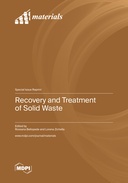Explore

Recovery and Treatment of Solid Waste
0 Ungluers have
Faved this Work
Login to Fave
The recovery of solid waste is a challenge and an opportunity for companies, thanks to the ongoing awareness of sustainability and technological advances. The end-of-waste criteria constitute a European strategic goal that promotes recycling in order to ensure a high level of environmental protection by means of reducing the quantity of waste destined for disposal. This Special Issue promotes the knowledge regarding technological methods for solid waste recovery. Articles investigate innovative processing methods with the goal of valorizing solid waste from different civil and industrial activities. Topics includes studies on construction and building, mining, plastics, and WEEE, referring to the treatment techniques used and, where appropriate, the critical raw materials that can be valorized. The recovery processes of critical raw materials can be very energy-intensive, affecting environmental and soil factors. Case studies on sustainable, low-carbon and resource-efficient techniques for the purpose of a more competitive economy were also very welcomed. The environmental impact and safety measures, especially for dangerous waste, should be taken into account in the description of their processing and management.
This book is included in DOAB.
Why read this book? Have your say.
You must be logged in to comment.
Rights Information
Are you the author or publisher of this work? If so, you can claim it as yours by registering as an Unglue.it rights holder.Downloads
This work has been downloaded 71 times via unglue.it ebook links.
- 71 - pdf (CC BY) at Unglue.it.
Keywords
- active compounds
- air flow rate
- alkali-activated cement
- aluminum dross
- anorthite
- anticorrosion agents
- apple pomace
- arc furnace slag
- bio-insulating material
- biochar
- biochemical methane potential
- biodegradable materials
- biogas
- biogas production kinetics
- biomethane
- biopolymers
- Building materials
- by-pass cement
- calcined dolomite
- calcined magnesite
- calorific value
- cathode ray tube
- ceramic sludge
- Chromium
- Circular Economy
- composting
- compressive strength
- copper recovery
- Crystallization
- diopside
- economic assessment
- Environmental assessment
- Environmental science, engineering & technology
- extraction
- Fibers
- flocculation
- geopolymer
- geopolymers
- glass wool
- glass–ceramics
- green composite material
- hemp stalk
- high-performance concrete
- hydrothermal carbonization
- industrial waste
- industrial wastes
- K-struvite
- kinetics
- lead leaching and electrodeposition
- lead recovery
- loss on ignition
- low-temperature processing
- materials separation
- mechanical pre-treatment
- mechanical strength
- metal recovery
- metals dissolution
- methane fermentation
- Monitoring
- municipal solid waste
- optimization
- parawollastonite
- PCB
- pet
- phosphate cements
- pipe jacking
- pollutants washout
- porous ceramics
- process characterization
- process modeling and simulation
- production waste
- pyrolysis
- quartz sand
- recycling
- renewable energy
- rock wool
- SEM/EDS
- solid fuel
- solidification
- sound absorbing properties
- spatial distributions
- sustainability
- sustainability development
- Technology, engineering, agriculture
- Technology: general issues
- temperature
- thermal absorption properties
- thermodynamic analysis
- torrefaction
- ultra-high-performance concrete
- Waste management
- waste slurry
- waste to carbon
- water absorption
- WEEE (waste of electric and electronic equipment) recycling
- WPCBs dismantling
- β-wollastonite
Links
DOI: 10.3390/books978-3-0365-7711-1Editions

